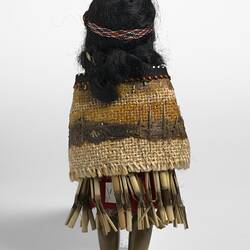Summary
Note: This object might be considered by some to be a cultural stereotype. Such representations are not condoned by Museums Victoria which considers them to be racist. Historical distance and context do not excuse or erase this fact.
National Doll produced to represent a Maori woman. Dolls are among the most universal toys found throughout the world and through history. Ornamental dolls can also be used to represent aspects of cultural traditions, such as dress.
The Maori are the indigenous Polynesian people of New Zealand (or Aotearoa). After Europeans arrived in the late 19th Century, the Maori population declined as the result of war and disease. However in the late 19th century, the Maori population began to increase, and during the 1960s there was a strong Maori cultural revival which continues today.
This doll comes from a collection of approximately 150 dolls in an array of national and regional costumes which were collected by Edna Setford from 1964-1988. Her husband Clifford continued the collection until his death in 1997. The collection is the work of both Edna and Clifford as well as many friends and family who brought dolls home to Edna as gifts from overseas trips. The final doll arrived two days after Clifford's death.
These dolls were purchased as souvenirs of particular countries and like many mass produced souvenirs they are often not accurate representations of a particular country or region, and may actually better reflect neighbouring counties or regions. This occurs because costumes are often stylised and simplified resulting dolls wearing generic costume elements which are common to many countries/regions. Often the fabrics and decorations used are selected to make the dolls cheap and easy to manufacture and aesthetically pleasing. This can result in the fabrics, colours and decorations of the doll's clothing having little or no reflection of the costume associated with a particular country or region they are meant to be representative of.
Physical Description
Dark brown plastic female doll, with dark eyes and black hair. The doll is dressed in a skirt made from plant material, a bandu style top in red, black and white, with a matching headband and a cape in brown and green.
More Information
-
Collecting Areas
-
Acquisition Information
Donation from Eril Wangerek, 01 Sep 1997
-
User
Mr & Mrs Edna & Clifford Setford, Victoria, Australia, circa 1964-1997
Owners of this doll collection which was acquired during this period. -
Place Depicted
New Zealand
This doll is intended to represent an Maori woman -
Classification
-
Category
-
Discipline
-
Type of item
-
Keywords
Keepsakes, Maori Culture, Maoris, National Costumes, Souvenirs, Travel



